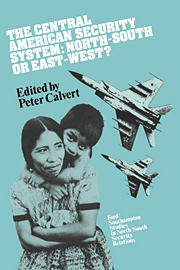Book contents
- Frontmatter
- Contents
- Notes on contributors
- Preface
- Map of the Caribbean Basin area
- Part I The problem at the interstate level
- Part II The problem at the state level
- 5 Cuba: a client state
- 6 Nicaraguan security perceptions
- 7 The security of small Caribbean states: a case-study of Jamaican experiences in the 1970s
- 8 United States' security perceptions
- Part III Solutions
- Index
8 - United States' security perceptions
Published online by Cambridge University Press: 15 October 2009
- Frontmatter
- Contents
- Notes on contributors
- Preface
- Map of the Caribbean Basin area
- Part I The problem at the interstate level
- Part II The problem at the state level
- 5 Cuba: a client state
- 6 Nicaraguan security perceptions
- 7 The security of small Caribbean states: a case-study of Jamaican experiences in the 1970s
- 8 United States' security perceptions
- Part III Solutions
- Index
Summary
Because at the moment United States’ policy towards Central America seems so rigid and one-sided, it is all too easy to forget that, over the long term, this policy has been variable and ambiguous. The force of this observation can be brought home clearly by any visit to the Dominican Republic, where the United States is remembered not only as the country that supported Trujillo and Balaguer, and sent in Marines in 1965, but also as the country that in 1961 conspired to assassinate Trujillo and then to prevent the reimposition of the rule of members of his family, and which in 1978 forced the military to accept the results of an election in which Antonio Guzmán, the candidate of the Dominican Revolutionary Party, defeated Balaguer, the favoured military candidate.
Here clearly is one source of variability in US policy: the fact that different United States administrations do not perceive American interests and values in the same way.
In the present chapter it will also be suggested that other sources of variability lie in the facts that the United States adopts different strategies depending on whether it conceives of the threat of revolution in an area as remote or immediate; that, because possible threats to national security lie always in the realm of the hypothetical, the same situation can be defined in quite different terms, depending on the premises adopted; and that there is a lack of synchronization in the way in which different sub-regions in the area are evolving with respect to United States hegemony.
- Type
- Chapter
- Information
- The Central American Security SystemNorth-South or East-West?, pp. 121 - 132Publisher: Cambridge University PressPrint publication year: 1988



